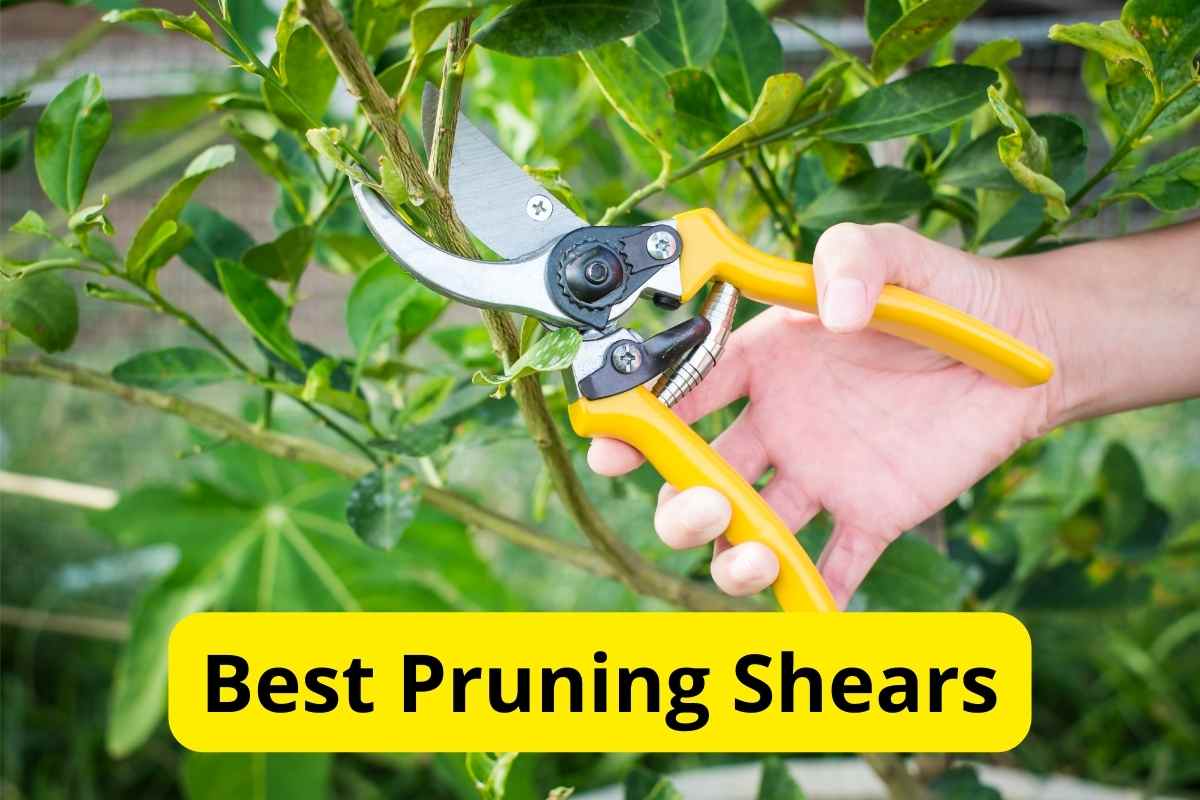
Your rose bush and hydrangea need trimming, but the shears you bought for that hair bob won’t cut it. What you need are some gardening shears, and we’ve got the 10 best pruning shears to put on your list.
We scouted the market top to bottom for the best pruners and rounded up our top 10 picks. We’ve also included a detailed buyers guide with helpful tips on finding the best pruning tool for you and your garden.
Pruning shears vary by blade material, comfort, and cutting capacity, which means some models might suit your needs better than others. Our 10 Best Pruning Shears list includes 4 bypass shears, 3 anvil pruners, and 3 ratchet pruners.
What makes these three pruning shears different?
- Bypass pruners are best for cutting living plants
- Anvil pruners are best for pruning dead or dried-out plants.
- Ratchet pruners are a type of anvil pruner, but they make the job much easier on the hands.
You can learn more about the different shear types in our detailed buyers guide below.
Pro Tip: When searching for the perfect pruning shear, it’s smart to shop in person. That way, you can feel how comfortable the tool is in your hand, as every pruning shear is different (and so is every hand). Just don’t forget to bring along our list of the 10 best pruning shears.
10 Top Pruning Shears [Reviews]
1. Best Bypass Pruners: ClassicPRO Titanium Pruning Shears
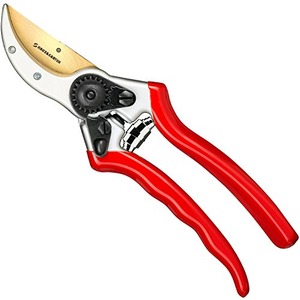
ClassicPRO Titanium Pruning Shears
This pruner can handle thick branches, is comfortable in your hands, and is rust-resistant.
Looking for a powerful bypass pruner that can manage thick branches, is easy on the hands, and resists rust? Check out the ClassicPRO Titanium Pruning Shears.
These gardening shears ranked at the top of our list for a good reason. The titanium coating protects the blade from corrosion, making for a longer blade lifespan. The pruning shears can tackle nearly any branch in the garden up to 1-inch thick, including shrubs, hedges, and trees.
These shears also make precise cuts for more delicate plants, like rose stems and ornamentals.
And these shears won’t tire out your hands because they have an ergonomically engineered, anti-slip, shock-absorbing, cushioned grip to reduce hand fatigue and wrist strain.
This gardening tool also allows manual adjustment of the cutting blade for the most precise snips, a sap groove to prevent the blades from sticking, and a convenient wire-cutting notch.
Specifications
- Shear Type: Bypass
- Blade Material: Stainless steel with protective titanium coating
- Cutting Capacity: 1 inch
Pros:
✓ Titanium coating prevents corrosion
✓ Large cutting capacity
✓ Blades are replaceable
✓ Adjustable blade alignment means cleaner, more accurate cuts
✓ Has a wire-cutting notch
✓ Sap groove helps prevent blades from sticking
✓ Ergonomic design reduces wrist and hand strain
✓ Equipped with locking mechanism and spring
Cons:
✗ Some users report the steel blades had nicks and dents only after a few uses
✗ Some users say this pair of pruners has an inadequate locking mechanism
2. Best Bypass Pruners: Fiskars Professional Bypass Pruning Shears
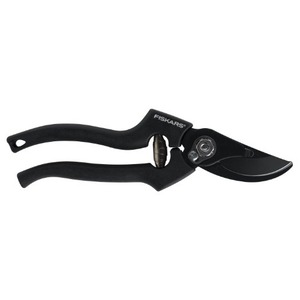
Fiskars Professional Bypass Pruning Shears
This pruner snips through stems with impressive strength, and is designed to handle wrist fatigue.
The Fiskars Professional Bypass Pruning Shears makes gardening easy. These shears are equipped with hardened steel blades and a 1-inch cutting capacity, snipping through nearly any stem in your garden. Users report that the shears have impressive strength, handling even the most demanding work on thick stems.
These Fiskars bypass hand pruners boast a self-cleaning gap groove, angled cutting head to reduce wrist fatigue, convenient hang hole for easy storage, and rust-resistant coating. Users can also adjust the blade tension, a handy feature not found on all garden pruners.
Specifications
- Shear Type: Bypass
- Blade Material: Hardened steel
- Cutting Capacity: 1 inch
Pros:
✓ Large cutting capacity
✓ Angled cutting head designed to reduce wrist fatigue
✓ Convenient hang hole
✓ Rust-resistant, low-friction blade coating
✓ Self-cleaning sap groove
✓ Adjustable blade tension
✓ Equipped with locking mechanism and spring
Cons:
✗ Some consumers report the pruning shears came loose and fell apart after only a few uses.
✗ Does not advertise replaceable parts
3. Best Bypass Pruners: Gonicc 8″ Professional Sharp Bypass Pruning Shears (GPPS-1002)
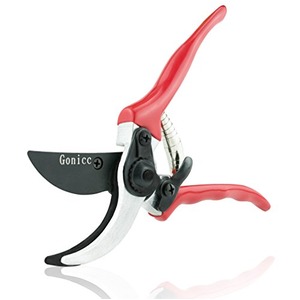
Gonicc 8″ Professional Sharp Bypass Pruning Shears (GPPS-1002)
This pruner has high carbon steel blades for maximum strength and longevity.
The Gonicc 8-inch Professional Sharp Bypass Pruning Shears (GPPS-1002) boasts high carbon steel blades for optimal durability and strength.
What does this mean for the avid gardener? High carbon steel ensures a longer blade lifespan than most steel grades, including stainless steel.
These ergonomically designed, non-slip pruners are also more affordable than our top pick, the ClassicPRO. They’re an excellent choice for trimming and shaping trees, rose bushes, bonsai, flowers, and vegetables. The tool also features a sap groove to ensure the blades don’t stick together as you work.
Specifications
- Shear Type: Bypass
- Blade Material: High carbon steel
- Cutting Capacity: ¾ inch
Pros:
✓ High carbon steel blades ensure optimal durability and a long lifespan
✓ Non-slip, ergonomic handles
✓ Sap groove helps prevent blades from sticking together
✓ Equipped with locking mechanism and spring
✓ Users report the pruners cut with excellent precision
✓ Large cutting capacity
Cons:
✗ Some users experienced the spring popping out of place
✗ Some users report a gap developed between the blades after pruning, making the shears inoperable.
✗ Does not advertise replaceable parts
4. Best Bypass Pruners: Mr. Pen Pruning Shears
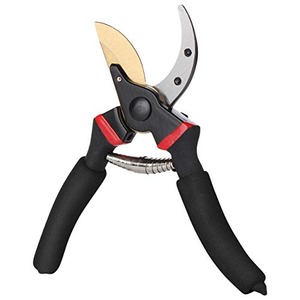
Mr. Pen Pruning Shears
This pruner’s padded handles keeps your hand comfy and make work simple.
After tending to a few bushes, an aching wrist and sore hand can slow down your work. That’s why gardeners are praising the Mr. Pen Pruning Shears for the comfortable, non-slip, padded handles. A tool that keeps your hand comfortable and makes work a breeze is worth having in the tool shed.
Users remark on the shears’ impressively sharp titanium-coated blades. These shears are also the most affordable on our list.
Specifications
- Shear Type: Bypass
- Blade Material: Titanium coated
- Cutting Capacity: ¾ inch
Pros:
✓ Most affordable pruning shears on our list
✓ Padded handles increase user-comfort
✓ Equipped with locking mechanism and spring
✓ Large cutting capacity
Cons:
✗ Does not advertise a built-in sap groove or non-stick coating
✗ Does not advertise replaceable parts
✗ Users report the shears should be used for light-duty pruning only
1. Best Anvil Pruners: Gonicc 8″ Professional SK-5 Steel Blade Sharp Anvil Pruning Shears (GPPS-1001)
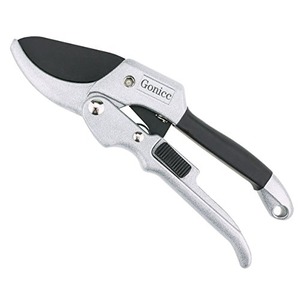
Gonicc 8″ Professional SK-5 Steel Blade Sharp Anvil Pruning Shears (GPPS-1001)
If dead plant limbs are what you need to cut, you might prefer using anvil pruners instead of bypass.
If dead plant limbs are what you need to cut, you might prefer using anvil pruners instead of bypass. The Gonicc 8-inch Professional Anvil Pruning Shears (GPPS-1001) ranks top of our list as the best anvil pruning shears.
Buyers praise the tool for its sharp, high carbon steel blades and ergonomic design. The pruning shears feature a pulley and spring-loaded mechanism for an effortless operation. And users with arthritis report the tool is exceptionally easy on the hands.
The Gonicc 8-inch Professional Anvil Pruning Shears (GPPS-1001) touts a long-lasting high carbon steel blade, high cutting capacity, and user comfort.
Even better? It’s half the cost of the runner-up anvil pruner, coming in at less than $20 (note that prices are subject to change).
Specifications
- Shear Type: Anvil
- Blade Material: High carbon steel
- Cutting Capacity: ¾ inch
Pros:
✓ Ergonomically designed, non-slip handles
✓ Equipped with locking mechanism and spring
✓ Affordable
✓ Users with arthritis report the tool is comfortable to use
✓ Has a high carbon steel blade
✓ Large cutting capacity
Cons:
✗ Does not advertise a built-in sap groove or nonstick coating
✗ Does not advertise replaceable parts
✗ Some users report that the shears have a short lifespan
2. Best Anvil Pruners: Felco Pruning Shears (F 31)
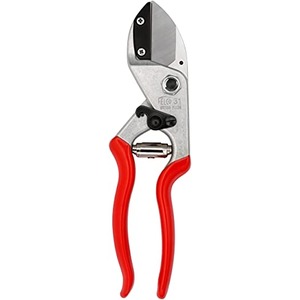
Felco Pruning Shears (F 31)
The Felco Pruning Shears (F 31) are an excellent set of shears, but they are expensive.
The Felco Pruning Shears (F 31) is a great pair of shears, but these shears come at a hefty price.
Many gardeners find these pruning shears worth every penny, as is reflected in the over 11,000 five-star Amazon ratings. On the other hand, gardeners shopping on a budget might find a better bang for the buck elsewhere.
All components in the Felco Pruning Shears (F 31) are replaceable, so you won’t have to buy a new set of shears when a single part stops working. That’s a huge advantage this set of shears has over other shears, as many pruners provide only a blade replacement or no replacement parts at all.
The Felco Pruning Shears (F 31) cuts branches up to 0.98-inches thick, snips wires, and is ergonomically designed with cushioned-shock absorbers.
Users rave about how comfortable the tool is to hold, its relentless power, and its long lifespan. Many gardeners even write that this is an essential tool to have in the gardening shed.
Specifications
- Shear Type: Anvil
- Blade Material: Hardened steel
- Cutting Capacity: 0.98 inch
Pros:
✓ All components are replaceable
✓ Ergonomic hand-fitting design.
✓ Large cutting capacity
✓ Cuts wires
✓ Sap groove helps prevent blades from sticking
✓ Has over 11,000 five star Amazon ratings
✓ Equipped with locking mechanism and spring
Cons:
✗ Expensive
✗ Some users report the blades rust unexpectedly fast
3. Best Anvil Pruners: Mockins Professional Heavy Duty Garden Anvil Pruning Shears
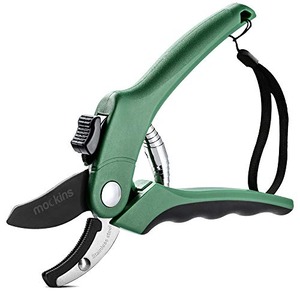
Mockins Professional Heavy Duty Garden Anvil Pruning Shears
This pair of shears is affordable, comfortable, and easy to use.
If you’re using pruning shears for the first time, you might like an affordable pair that’s easy and comfortable to use. The Mockins Professional Heavy Duty Garden Anvil Pruning Shears are great for pruning dead or dried-out limbs, and they won’t take a big bite out of your wallet.
Equipped with stainless steel blades, ergonomic rubber handles, and a 8 mm cutting capacity, this inexpensive pair of high-quality shears markets itself as a smart choice for gardeners pruning for the first time.
Pro Tip: Do not use these pruners on your live plants, as anvil pruners will crush them rather than cut them.
Specifications:
- Shear Type: Anvil
- Blade Material: Stainless steel
- Cutting Capacity: 8 mm
Pros:
✓ Users report these shears are a reliable choice for gardeners pruning for the first time
✓ Most affordable gardening shears on our list
✓ Equipped with locking mechanism and spring
✓ Ergonomic rubber handles
Cons:
✗ Small cutting capacity
✗ Does not advertise a built-in sap groove or nonstick coating
✗ Does not advertise replaceable parts
✗ Despite being advertised as heavy duty, users report the tool is more ideal for light duty work.
1. Best Ratchet Pruners: EZ Kut Heavy Duty Pruning Shears
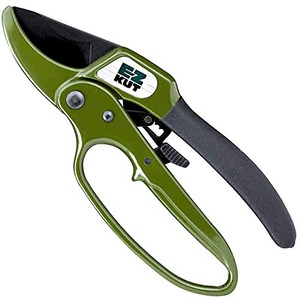
EZ Kut Heavy Duty Pruning Shears
Gardeners who require extra power to cut through thicker branches should opt for the EZ Kut Heavy Duty Pruning Shears.
The EZ Kut Heavy Duty Pruning Shears is the perfect choice for gardeners who need to tackle those thicker branches with extra power.
These shears are ratchet pruners, a type of anvil pruner that lets you slice through branches in multiple steps to preserve your energy instead of exerting your hand strength in one slice.
The EZ Kut Heavy Duty Pruning Shears shows off a whopping 1.5-inch cutting capacity, hardened carbon steel blades, cushioned handles, and shock-absorbing pads. This garden tool also features a non-stick coating to help minimize tree pulp buildup and a replaceable blade.
These ratchet pruning shears also come in bright pink when you buy from the EZ Kut Store, so you can work in style — and find them easily in the grass or brush.
Specifications
- Shear Type: Ratchet
- Blade Material: Hardened carbon steel
- Cutting Capacity: 1.5 inch
Pros:
✓ Hardened carbon steel blade
✓ Largest cutting capacity on our list
✓ Non-stick coating
✓ Equipped with locking mechanism
✓ Cushioned handles with shock-absorbing pads
✓ Come in bright pink and green
✓ Blade is replaceable
Cons:
✗ Expensive
✗ Some users report the pruners are not ideal for weak or small hands
2. Best Ratchet Pruners: Garden Guru Ratchet Hand Pruning Shears
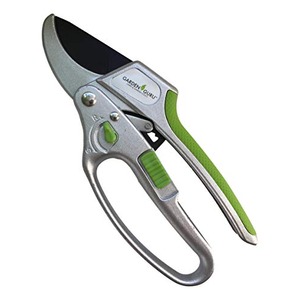
Garden Guru Ratchet Hand Pruning Shears
Great for precision cuts and trimming flowers, shrubs, and stems. Slices through with accuracy and ease.
The Garden Guru Ratchet Hand Pruning Shears can tackle plant stems and limbs up to 1-inch thick — at half the cost of the EZ Kut shears.
The Garden Guru’s high carbon steel blade is advertised to cut cleanly without crushing plant material, a common trait of anvil and ratchet pruners (bypass pruners typically have the cleanest cut).
What this means: With the Garden Guru Ratchet Hand Pruning Shears, you can expect clean cuts from the ratchet mechanism and don’t worry about fraying or crushing dead, dried-out stems.
Specifications
- Shear Type: Ratchet
- Blade Material: High carbon steel
- Cutting Capacity: 1 inch
Pros:
✓ High carbon steel blade
✓ Affordable
✓ Non-stick protective coating
✓ Large cutting capacity
✓ Equipped with locking mechanism
✓ Ergonomic grip
✓ Marketed as having a clean cut
Cons:
✗ Does not advertise replaceable parts
✗ Some users note the shears feel flimsy
3. Best Ratchet Pruners: The Gardener’s Friend Pruners
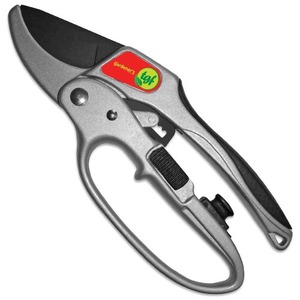
The Gardener’s Friend Pruners
These shears were designed with comfort in mind and built to ensure no more painful pruning and strain.
Our third-place ratchet pruner winner is The Gardener’s Friend Pruners, a tool developed by professional gardeners from a family-run nursery. These shears were designed with comfort in mind and built to ensure no more painful pruning and strain.
The Gardener’s Friend Pruners is a great choice for gardeners with limited hand strength, arthritis, or carpal tunnel syndrome.
The 3-stage action ratchet pruner also features a hardened carbon steel blade, 1-inch cutting capacity, and replaceable blade.
Specifications
- Shear Type: Ratchet
- Blade Material: Hardened carbon steel
- Cutting Capacity: 1 inch
Pros:
✓ Hardened carbon steel blade
✓ Large cutting capacity
✓ Equipped with locking mechanism
✓ Replaceable blade
✓ Designed to ensure comfortable and painless pruning
✓ Developed by professional gardeners from a family-run nursery
Cons:
✗ Does not advertise a built-in sap groove or nonstick coating
✗ Expensive
✗ Some users report the pruners are difficult to use
Buyers Guide
Before saying “I do” to a good pair of pruning shears, consider what your needs are (this way no one gets hurt). Cutting tough branches with the wrong pruner can put a lot of strain on the wrist and damage the plant, too.
Let’s take a closer look at the various factors that go into designing a pair of pruning shears so you can make the best choice for yourself and your green friends.
Pruner Type
There are three common pruner shear types: bypass, anvil, and ratchet. Each pruner type has a different cutting mechanism and won’t work for every plant. Keep this factor in mind when you read negative reviews regarding the tool’s cutting capability, as sometimes it’s clear the gardener did not use the correct shears for the plant.
But how do you know which are the best garden pruners for your plants? It’s easy: It comes down to whether the plant is dead or alive and your hand strength.
Bypass pruners
Bypass pruners are best reserved for living plants. They’re the most popular shears choice among gardeners as most gardeners grow flowers, vegetables, and fruits.
Bypass pruners operate similarly to a regular pair of scissors. The top blade passes over the bottom blade in a scissor-like motion to create a clean, crisp cut.
Anvil pruners
Anvil pruners are good for dead or dried-out plants, such as dead tree branches. Rather than have two blades bypass one another, the sharp top blade presses down against an unsharpened, flat anvil. Instead of a slicing motion, an anvil pruner crushes the plant limb against the flat edge.
Avoid using anvil pruners on your live, green plants, as the crushing motion is not healthy for these plants and might fray the stems.
Ratchet pruners
Ratchet pruners are a type of anvil pruner preferred by gardeners who experience hand pain while pruning. Instead of slicing through the branch in one squeeze, a ratchet pruner cuts the plant in stages.
While you squeeze and release your grip on the pruner, the ratchet pruner maintains its cutting progress without springing open again. Breaking down the snipping motion into several steps helps to relieve hand pain.
Blade Material
Blades are an essential part of a pruner’s longevity. After repeated use, a blade will begin to nick, dent, and corrode. Higher quality blades are more expensive, but they do make for a better pruner.
Carbon Steel
The highest quality hand pruners will have carbon steel blades. These blades are the strongest blade type and most appropriate for heavy-duty work.
The downside to carbon steel blades is the susceptibility to corrosion. Gardeners need to keep carbon steel blades well maintained if they want to delay rust.
Titanium
Titanium pruning blades aren’t usually a solid block of titanium. Instead, these are steel blades with a protective titanium coating. Titanium makes for a tough blade that can resist corrosion, making titanium an attractive alternative to high carbon steel.
But not all gardeners find titanium blades worth the added cost. Since titanium is only a coating, it will eventually wear off the more you sharpen the blade.
Stainless or Other Steel Grades
Stainless steel (or other steel grades) is often the most affordable blade type, but these blades aren’t as durable as carbon steel or titanium-coated blades. A significant advantage to stainless steel blades is that they don’t rust.
Ergonomics
High carbon steel blades with excellent cutting power can feel like an easy buy, but if the pruners are uncomfortable or hurt your hand, that’s like throwing your money down the drain.
Look for pruning shears advertising an ergonomic design that prioritizes user comfort. Ergonomic features include non-slip grips, padded handles, shock-absorbers, and comfortable handle shape.
Operating pruning shears that are comfortable to hold will increase pruning productivity. Pausing your work to relieve stress in the wrist or fingers will only slow down your work.
Replacement Parts
Some pruning shears advertise replaceable blades or other essential parts. Replaceable parts are critical to a longer tool lifespan and often save you money.
If a small fragment comes loose on your pruning shears and the manufacturer doesn’t offer replacement parts, that’s usually the end of your tool’s life.
What this means: Owning pruners without replaceable parts often results in buying multiple pruners over time, whereas owning a pruner with replaceable parts means you’ll have the same tool for longer and likely spend less money in the long run.
Locking Mechanism
Most pruning shears have a locking mechanism. This feature helps ensure the pruners don’t pop open while in your shorts or hands, as the sharp blades can be dangerous.
Some locking mechanisms are better than others. A common problem gardeners experience — a faulty pruning shear automatically locks after each snip. To help ensure your blade’s locking mechanism is effective, test it in the store or return your shears for a new pair (if the store’s policy allows this).
Built-in Spring
When shopping for a pair of pruning shears, make sure your bypass or anvil pruner has a built-in spring. A spring ensures the blades pop open again after each cut so that you don’t have to pry them open manually.
Most springs are visibly attached between the handles, though some springs are not as easy to see. Just because you can’t spot the spring doesn’t mean it’s not there, so read the product description carefully.
Sap Groove
Many pruning shears come with a sap groove or non-stick coating. This feature helps prevent the blades from sticking together as you work. Sticky blades will make your pruning job harder.
Hand Size
Remember, there are many different shaped hands in the world, along with many shaped pruners. Not all pruners will fit comfortably in your hand, which is why it’s helpful to shop in-store or check the handle dimensions online.
Here’s why: Operating garden shears that are too big for smaller hands will lead to more discomfort and less time pruning.
Still have questions? A visual guide always helps. Check out this handy pruning shears buyers guide with Kevin from Epic Gardening.
How We Measured
Comparing cutting capacities, blade materials, and special features takes time and attention to detail. That’s why we took care of the research for you.
After gathering the specifications for several pruners on the market, we ranked each tool in seven to eight categories and took a weighted average of their scores.
The rankings for bypass and anvil pruners looked something like this:
- Cost: 10%
- Blade material: 25%
- Cutting capacity: 20%
- Advertised as ergonomic or comfortable to use? (Yes or No): 10%
- Advertised as having replaceable parts? (Yes or No): 10%
- Equipped with a locking mechanism? (Yes or No): 10%
- Equipped with a spring? (Yes or No?): 10%
- Equipped with built-in sap groove or non-stick coating? (Yes or No): 5%
The rankings for ratchet pruners were similar, but without the spring requirement (as ratchet pruners needn’t spring back):
- Cost: 10%
- Blade material: 30%
- Cutting capacity: 25%
- Advertised as ergonomic or comfortable to use? (Yes or No): 10%
- Advertised as having replaceable parts? (Yes or No): 10%
- Equipped with a locking mechanism? (Yes or No): 10%
- Equipped with built-in sap groove or non-stick coating? (Yes or No): 5%
FAQs About Pruning Shears
There are many reasons you may want to prune your plants. Hand pruners help eliminate dead parts of the plant, promote new growth, and even prevent pest infestations. Pruning also enables you to achieve the desired shape you’d like your plant to be, such as a prized rose bush.
When your pruning shears are dull, there’s no need to toss them out. Sharpening your blades and keeping them well maintained is the key to enhancing the tool’s lifespan (and keeping your wallet fat).
Remember to:
— Keep your blades sharp. Disassembling the pruning shears is the best way to ensure the file sharpens the entire blade.
— Remove dirt and muck with warm, soapy water.
— Remove rust with coarse steel wool.
— After reassembling the pruners, lubricate the shears with a coat of oil.
— Wipe your shears and store them in a dry location.
Secateurs and pruners are two different terms to describe the same tool. Depending on where you live in the world, you might call this handy tool secateurs or pruners. Either is correct.
Note that hedge trimmers and loppers are different from pruning shears, but they perform a similar job.
Conclusion
If you were previously on the fence about buying yourself a pair of top-quality pruners, our list of the best pruning shears and buyers guide should get you off the fence, in the store and trimming trees and bushes in your yard.
Or maybe you fear lopping off a finger with your lopper?
You always can call a local landscaping professional near you to take care of the garden to-do list while you sit back and relax. A pro can mulch the flower beds, edge the yard, trim the hedges, and even prune the plants.
Afterward, your garden will love its new do.
LawnStarter participates in the Amazon Services LLC Associates Program and other retailer affiliate programs. LawnStarter may earn revenue from products promoted in this article.
Main Image Credit: Isarapic / Canva Pro / License wih Text Overlay using Canva Pro